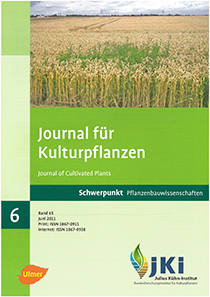Harvest of Jerusalem artichoke (<em>Helianthus tuberosus L.</em>) with grazing pigs compared to mechanical harvest
DOI:
https://doi.org/10.5073/JfK.2011.06.02Keywords:
Energy crops, tuber, volunteers, crop rotation, bioenergyAbstract
The cultivation of Jerusalem artichoke (Helianthus tuberosus L.) for bioenergy is not yet realised, although the potential is quite promising. About 1/3 of the tubers remain in the soil after harvesting which can sprout next year, and result in highly competitive volunteer plants in the following crops. Two different methods of tuber harvesting were tested in a field trial 2009 and 2010: grazing pigs, and a single row potato harvester. The methods differed in time and period of harvesting (grazing pigs: 50 days between May and October, mechanical harvest: one day in March). Six grazing pigs were used for an area of 96 m2 with Jerusalem artichoke tubers and each pig harvested on average per day an area of 0,34 m2. The number of tubers was counted immediately before and after harvesting. Tubers which were not recovered at harvest were recorded as volunteers in the following crop. Tuber harvesting by grazing pigs showed lowest number of lost tubers (< 3 tubers m–2) compared to an average of 74 tubers m–2 after the mechanical harvest. This difference was also clearly visible in the number of volunteers in the following crop (grazing pigs: < 1 volunteers m–2, mechanical harvest: 31 volunteers m–2). Tuber harvesting by grazing pigs is an option for efficient reduction of Jerusalem artichoke volunteers in the following crop, but only feasible for a few farms.
Downloads
Published
Issue
Section
License
The content of the journal is licensed under the Creative Commons Attribution 4.0 License. Any user is free to share and adapt (remix, transform, build upon) the content as long as the original publication is attributed (authors, title, year, journal, issue, pages).
The copyright of the published work remains with the authors. The authors grant the Journal of Cultivated Plants, the Julius Kühn-Institut and the OpenAgrar repository the non-exclusive right to distribute and exploit the work.







